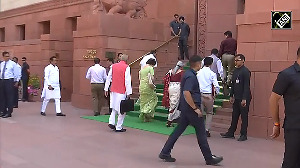Some automobile makers want the Union ministry for road transport and highways to raise the weight cap on quadricycles from 450 kg to 600 kg.

The rules for quadricycles came into force from October 1.
In a month's time, there is hectic lobbying to alter a key provision of the rules!
The notification was also challenged in the courts by individuals.
While some of these have been dismissed, the Karnataka High Court has admitted a plea that it will hear next week.
This is nothing but corporate rivalry at work.
At the moment, Bajaj Auto is the only company that has a quadricycle ready for launch, the RE60, which meets all the specifications laid down in the rules.
Quadricycles are meant to replace three-wheelers, which weigh about 350 kg each and sell about 400,000 units in a year.
Bajaj Auto has the first-mover advantage, which it could lose if the norms are changed.
That's because there are several four-wheelers, like Tata Motors' Magic Iris, which weigh slightly above 600 kg, and with some modifications, their weight can be brought down to help them qualify as quadricycles.
This will compress the go-to-market time for these companies.

Those that are developing quadricycles from scratch say it will take them at least two years to roll them out.
Rajiv Bajaj, the outspoken managing director of Bajaj Auto, has told this newspaper that any change in the norms could lead to two consequences.
One, it will blur the distinction between entry-level cars and quadricycles.
Many cars weigh around 700 kg, and need to go through rigorous safety tests that include crash tests.
Quadricycles do not have to go through crash tests because they move at lower speeds.

If the weights of quadricycles and entry-level cars become similar, it is quite possible that higher safety tests will be introduced for quadricycles as well.
This could spoil the business case for Bajaj Auto.
Over a period of time, Mr Bajaj fears, this will discredit quadricycles.
And two, heavier quadricycles will be less fuel-efficient and sluggish, which will defeat the purpose of fast and pollution-free urban transport they are supposed to serve - quadricycles can be used only within city limits, not on highways, and their top speed cannot exceed 70 kilometres an hour.

These are arguments that deserve serious consideration by the government. Quadricycles have been the subject of great discord among automobile makers right from the start.
When the government first talked of allowing quadricycles, some raised the issue of safety and called it a step backward.
Nitin Gadkari, the road transport minister, should realise that the latest request to raise the weight cap is an indication of corporate rivalry and he shouldn't succumb to lobbying without subjecting all arguments to an objective review on merits.
Quadricycles appear to be the appropriate alternative to three-wheelers.
They come with a hard top and passenger doors, which make them safer.
If Mr Gadkari entertains requests to change the norms, it will only delay the rollout of quadricycles.











 © 2025
© 2025